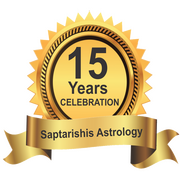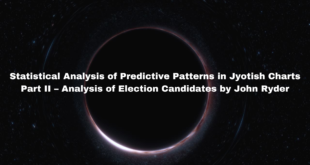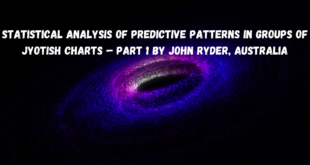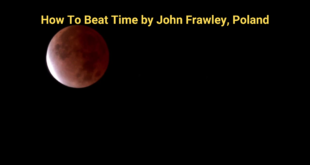Related Articles
SA Volunteer: Manish Gour
Special Thanks: AIAC Team, Chicago
‘Taken from The Astrological Magazine: Dec. 1977 issue
I just give some examples. If the Ascendant is Taurus and the sensitive point is Kumaramsa 1st part (Such a name is not found in any of the Shashtyamsas) the person will be the third issue to his parents; he will be born in a big town on the bank of a river, in the house of his own father situated in a street running north-south and the house facing the east. The delivery will be easy. If the birth is in the 2nd part of this sensitive point the place of birth will be a small one, birth having taken place in a relative’s house, situated in a street running east-west and the house facing the south. He will be the 4th issue, the eldest brother having died. The delivery will be difficult. In either case, the trimsamsa (or 1/30th division) will be that of Venus. If the ascending Node is also in the trimsamsa of Venus, as a result of his past sins he is liable to suffer from epileptic fits. In the subperiod of Jupiter and the major period of the 2nd asterism lord, when Saturn transits the end point of Taurus or the beginning of Gemini, mother’s death takes place. Again the Ascendant being Taurus and the sensitive point is komalamsa 1st part the person’s birth takes place in a relative’s house, situated in a street north-west—south-east, the house facing north-east. The delivery will be easy. In the 2nd half, the birth takes place in a hospital situated near a temple in the person’s mother’s house situated in a street running north—south and delivery takes place after much suffering for the mother. The person will be the 3rd issue to his parents, the first two brothers having died.
The trimsamsa or 1/30th division being that of Jupiter denotes a body inclined to corpulence. If the sensitive point is mangalamsa 1st part (Sri C.S.Patel lists this Nadi amsa as the 91st Nadi Amsa and lies between 17°:46′:41″ and 18°:00′:00″ in Movable signs, 11°:31′:00″ and 12°:00′:20″ in Fixed signs and 3°:00′:00″ and 3°:20′:00″ in Dual signs.) the birth will be in a small township near a big river. He will have a number of brothers but only one sister. He will suffer from lot of infantile troubles. His complexion will be blood-red. If the birth is in the 2nd part the birthplace will be in an industrial town. The delivery will be difficult. He will be fair-complexioned and he will have, alive, two brothers and two sisters. The father will be a petty official.
The following is a typical horoscope extracted from one of the versions of Dhruva
Nadi: Taurus Ascendant: Vasudhamsa (29° 48’ to 30 ).
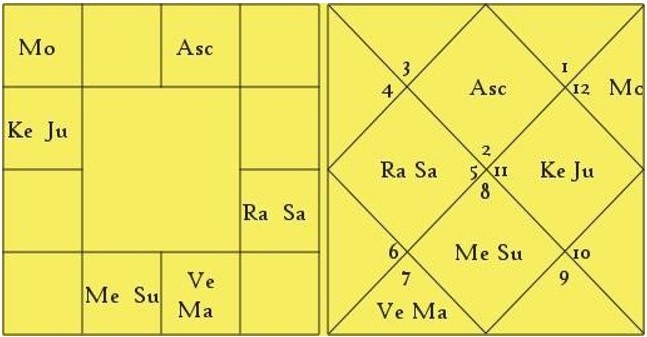
The native born in the first part of the vasudhamsa (29° 48’ to 29° 54’) (This is also in accordance with Deva Keralam. However, C.S. Patel has given the Vasudha Nadiamsa for Fixed signs from 29° 30’ to 30°) in the trimsamsa of Venus is a sudra by caste and is the 3rd or 4th child to his parents. He has an elder brother living and his younger brothers are dead. Lord of the 9th is in the 4th (Saturn in Leo) and lord of Lagna is associated with Mars. Jupiter is in the 10th. Therefore the native’s birthplace will be near a river. If it is the 2nd part of the Nadi Amsa (29’ 54’ to 30) his birth will be in a small town adjoining a forest. As Rahu is in the 4th the mother’s health will he afflicted at the time of native’s birth and will continue to be bad throughout the Janma Dasa i.e. the period of the planet ruling the birth constellation. Lord of the 4th (Sun) is in a kendra or quadrant (7th is given in the next paragraph) in association with the lord of the 5th(Mercury)(Taken to be in the 7th Kendra as otherwise the distance between Sun and
Mercury wil exceed the possible range if Sun is to be placed either in the 4th or 10th Kendra positions). The Moon is in the 11th. He will be fairly happy regarding parents. In the first sub-period of the second major period the native suffers from much bala-rishta (i.e., infantile disease).
Lord of the ascendant in his own house (Venus placed in Libra) and Jupiter in an angle or trine, the native has a full term of life. Mars in the 6th (Venus will also be placed here as in the previous paragraph it is stated that “Lord of Lagna is associated with Mars.” ) and Saturn in the ascendant, (This seems to be contradictory as it is stated above that Lord of 9th is in the 4th or probably this is a different combination as seen from the first line of next paragraph) the Sun in the 7th and Rahu in the 4th and Jupiter in the 10th, the native has two marriages; he owns lands, is virtuous, generous, and is happy with his wife and children. He is a well-wisher of the people and has a number of well-wishing friends. Sensual in nature he has extra-marital relations.
When the ascendant is vasudhamsa in a fixed sign the Sun occupies either a trine or an angle, and lord of the 9th is in the ascendant, (again the position of Saturn differes from the original one) the father will live up to middle age. The father is a devotee of Lord Siva and respects Brahmins and Saints. He becomes famous through friendship with rulers and secures a high position. In arudha – the Moon and Saturn are in association and hence mixed results follow in the major period of Saturn. The father will die in the last part of the third major period of the native.
Lord of the 4th strongly placed in kendra or trikona and the karaka in a Kendra,(Here the karaka for mother is not placed in a Kendra) he will have happy relations with mother. The mother is a lady of high character and she dies in the same period.
When birth is in vasudhamsa in a fixed sign and sakata yoga is present and trimsamsa is that of Venus, the native will have a well-proportioned body, darkish in complexion and the constitution will be of vata and pitta (a mixture). Ordinarily educated, he will be happy after 30. The effects of sakata yaga will he felt from the 16th year. As lord of Lagna is with Mars, the native will be adopted by a jnati (a distant relative) and hence he will have two fathers and two mothers.
As lord of the 6th is with Mars, he will inherit wealth from a jnati. He will suffer from sorrow till 27th year, gets married after 30, and gets two wives. He will have children late in life, the first issue being a daughter. Both his wives will beget children and he will have two sons. Two daughters will live and the rest will perish.
The native is righteously inclined and will be happy on account of children, who will look after him in his old age.
In the first Dasa he will have serious health problems twice or thrice. In the second Dasa (own sub-period), he will suffer from a peculiar fever; and to get cured, propitiate Saturn. In the Sun’s sub-period, the father falls seriously ill and the mother dies in the sub-period of the Moon.
When Saturn in his first round enters Libra, one born vasudhamsa will lose his mother. For those born in Taurus, Saturn’s transit of the 8th sign from the Moon causes mother’s death.
In Mars sub-period he will have much happiness from his elder brother. In Rahu’s sub-period, father will be ill and some fortunate results will happen. In Jupiter’s subperiod he will fall seriously ill. The first part of the third Dasa will be somewhat favorable. There will be good yoga in the latter half. Ketu as sub-lord will see him prosperous and Venus sub-period will be the best. In the Sun’s sub-period adopted father (sweekara pitru) will pass away. Mars sub-period will make him more prosperous and influential while Rahu’s sub-period will confer wealth, lands and other types of property.
Marriage takes place in Rahu’s sub-period in the third Dasa. Delayed marriage is due to sakata yoga. When the Sun occupies the 7th either with Venus or Mercury, marriage takes place in the third Dasa. A sakata yoga native will not only have delayed marriage but delayed issues.
The native’s wife will be fair-complexioned. She brings luck. Even when there is sakata yoga, nothing but good alone can happen provided the Moon is in a kendra (quadrant) from the ascendant, (Here it is not so) occupies a benefic sign, and Jupiter is also in a kendra or trikona (angle or trine). This is called samrajya sakatayoga and can manifest only after one’s 20th year. Even if Jupiter is associated with Ketu in a malefic sign, the yoga does not cease to function if benefic Navamsas are occupied by them. If the Moon is in the 5th, the first issue will be a female. For this native, father will pass away in the 4th Dasa, when Saturn, in his second cycle, transits Leo or Virgo. His subperiod in the 4th Dasa will see the birth of a son, when Jupiter in his 4th cycle passes through Taurus. In the 5th Dasa, during the sub-period of the Sun the native marries for the second time and gets immense benefits through Government sources.
A daughter and son will be born respectively in Saturn and Mercury’s sub-periods when Jupiter passes through Pisces. When Saturn transits Cancer, affliction will befall the ruler of Chola. When Saturn transits Aquarius, political revolution takes place. When Saturn passes through Scorpio there will be great fear of outbreak of war. The king or ruler of Pandya will pass away when Saturn enters Leo.
The first part of the 7th Dasa will cause untold suffering to the native, by way of much expenditure, displeasure of the rulers, etc. In his sub-period, the adopted mother dies.
The end of 8th Dasa (the sub-period of Venus) will cause the native’s death. His longevity is 78. Lord of the 12th (Mars) is with Venus. He is aspected by Venus.(Is it a typo error? Does he mention Jupiter/Saturn as these are the two planets aspecting Venus and Mars) Therefore he will go to punyaloka after death. His next birth will also be in a noble family.
References made in the horoscope given above to certain important combinations such as sakata yoga, planetary transits and the effects of such transits on certain parts of India are indeed significant.
In this manner are given particulars in respect of each sensitive point. The amsas or the 1/150th parts cannot be ordinarily used by an astrologer unless one is able to pick up the exact amsa by verificational methods.
The Nadi Granthas provide some interesting facts which can be of great value to predictive practitioners. The dwadasamsa or the 1/12th division indicates a certain general pattern of future, the trimsamsa or the 1/30th division, a more specific pattern and the Nadi amsa, the exact pattern. When one is not able to locate the exact basic point, one can study the horoscope on the basis of the dwadasamsa pattern which takes into account influences for every 2½°. This will be useful in predicting important events, even though the event cannot be narrowed down to days or months. The ascendant, the asterism and the dwadasamsa are all linked. The number of asterism being 27, and the number of dwadasamsas being 12, the number of combinations for each sign will be 324. I shall just give a few random combinations from the Nandi Nadi. Details have to be filled in by planetary influences.
Ascendant Aries (22½° to 25): Dwadasamsa 10th: Moon in Rohini (4th star): Belongs to higher middle class; proud, war-like and arrogant; very independent in views. Generally a strange career. Hasty, passionate, audacious and desirous of prominence. Aggressive and rash. Marriage unfortunate. Marriage takes place in the third main period and the sub-period of Venus, when Jupiter transits a trine from Venus. At the end of the main period, the husband or wife will fall seriously ill or die. At the age coinciding with the commencement of the fifth main period, he will meet with enmity and misunderstanding and in Rahu’s sub-period, coinciding with his transit (of the 1st, 3rd, 5th or 7th star) he will have a sudden fall from position. If the horoscope warrants birth of issues, he will have the first issue in the sub-period of Jupiter in the third main period. He will die in the 5th main period and the sub-period of the 7th lord.
Ascendant Taurus (12½° to 15°): 6th Dwadasamsa: Moon in Rohini (the 4th star); Excellent future, high ran. Diplomatic, secretive, obstinate, self-willed. If Venus is involved in a Raja Yoga (combination for fame) gives high education and fruitful imagination. Lord of the 9th, in a destructive constellation, father’s death in the 3rd main period and the Sun’s sub-period when Saturn transits the birth asterism. Mercury in vargottama (same position in the Rasi and Navamsa charts) in the 2nd house, eminence is attained by writing. Marriage in the main period of the 4th asterism lord and the subperiod of Venus when Jupiter transits a trine from Jupiter. Great honor in the main period of the 5th asterism lord and the sub-period of the Node. Death takes place at the end of the main period of the 7th asterism from birth-star.
Same Ascendant (12° to 15°) and Dwadasamsa but the Moon in Bharani (2nd star): Obstinate, sensitive, sensual, self-willed, short-tempered; a master of fore-knowledge, recorder of events. Marriage in the 2nd main period when Jupiter transits the 6th asterism. Great prosperity and eminence during the main period of the 6th asterism lord. Not much happiness on account of children; great ability in writing; highly learned; devoted to religion and God. Livelihood by trading. World famous, if mangalamsa rises. Father’s death in the 4th main period and the sub-period of the Moon when Saturn transits an angle from the Sun. Mother’s death in the 3rd main period and the sub-period of the Moon. His own death in the main period of Saturn and the sub-period of the Moon.
Ascendant Virgo (25° to 27½°); 10th Dwadasamsa and the Moon in Bharani (2nd star); An unostentatious person, ordinary rank; has a good brain with power of intuition and reasoning; fortune unsettled; gain through women; family life not happy. Religious fervor, philosophical inclinations; moral character good; retiring nature, critical, thoughtful and vacillating. Lacking in drive and ambition, success only in the 2nd part of life beginning from the main period of the lord of the 5th asterism from birth. Marriage takes place at the end of the 3rd main period, when Jupiter transits a trine place from the Moon. Death in the major period of the 7th asterism, when Saturn transits the 12th from the Moon.
Ascendant Libra (5° to 7½°: Dwadasamsa 3rd; the Moon in Purvashada (20th asterism); Strange and quixotic views. Ill-temper. Marriage not likely. Born in a humble middle class family. Slow but sudden rise in life. Parents die at the end of the 1st main period or the beginning of the 2nd main period, coinciding with Saturn’s transit of Scorpio. Incarceration in the 4th main period and the Sub-period of Saturn. Eminence in the 5th main period and fall when Saturn transits the constellation Occupied by the Node.
Ascendant Cancer (27½° to 30°); Dwadasamsa 12th: the Moon in Krittika: Selfwilled and domineering. Marriage not successful. Incarceration in the 3rd main period. Rise in life in the 4th main period and fall in the 6th main period when Saturn transits naidhana (7th) constellation.
From what I have said hitherto, you will notice that Nadi astrology gives an important place to the basic pattern of the horoscope revealed by dwadasamsa for a general outline and the nadi amsa for a comprehensive survey. The details such as attainment of rank, position and status, success, occupation, etc., are filled in by the planets and the various yogas or typical combinations formed by them. In actual practice, these principles can be easily demonstrated by applying them to well-known horoscopes. But that will only be a post-mortem study. After an event has happened, we can justify it in some way or other but it is in the prior application of these principles and prediction of events to happen in future that the real value of astrology lies. Just for the sake of curiosity, one may note that Hitler’s ascendant—as determined by me—falls in sankaryamsa of Libra. For this basic pattern, the description is: Not educated but wellinformed, likes music, a virulent orator, knows three languages, deceitful nature, and suffers greatly in the first and second Dasas. Becomes famous and rich in the 5th period, strange connections with women and tragic end in the 7th period. But for a kokilamsa (Libra ascendant) all events will be same but the person will be a religious head.
What is astonishing is the discovery of certain patterns of destiny capable of application to thousands of individuals born in different parts of the world. In the Nandi Nadi it is mentioned that subject to a small error, the types of human birth recur on a certain cyclic basis, so that these horoscopes can be considered as more or less valid for any number of years. This aspect of the question, we have yet to investigate. The Nadi writers have demonstrated in unmistakable terms the validity of the principles of traditional astrology, for apart from the destiny —patterns which they have discovered, predictions are given only on the basis of the traditional principles. The existence of palm leaf manuscripts containing some kind of ready-made horoscopes, universally valid, is no fiction. It is a reality and a fact of experience. India is still conservative and is a country of traditions. And since most astrologers who possess these Nadi-works are tradition- bound, they hold these manuscripts in great reverence especially that their authorship is traced to sages of yore; they cannot be moved from place to place and least of all taken outside India.
Investigations into the Nadi system of astrology have brought out several important matters of astrological interest.
First: the existence of certain basic patterns of destiny: We do not know whether these ‘basic patterns’ were obtained by observation and study or by intuitional methods or by a combination of both the processes. But there they are. The method does not matter. In the evaluation of results, some of the Nadis go a step further and suggest that planetary influences also vary with regard to each minute unit used for determining the basic patterns of destiny. I think the nearest in approach to the Nadi Amsas, to be found in Western astrology, are the degree influences, most of them symbolical.
Second: Nadi astrology demonstrates clearly that Hindu astrology gives great importance to the fixed stars, for the author of Sukra Nadi lays emphasis on the 27 asterisms and the 108 quarters. He says that the stellar zodiac is something like a cosmic ocean in which the celestial bodies swim like fish in water.
Third: There are certain conditional predictions given in respect of some bad events in certain horoscopes, such as for instance, serious sickness or death of a wife, etc., suggesting that the affliction can be overcome by suitable remedial measures implying thereby scope for exercise of man’s volition.
Fourth: In regard to prediction of events, the Dasas or the directions or progressions are of primary importance. What is not shown in the birth horoscope cannot happen, whatever be the strength of the transit influences. Transits are only secondary in importance. They probably act as catalytic agents. But there should always be a blending of the directional and transit influences for the happening of an event.
Fifth: The subject of house division which appears to puzzle many an astrologer in the West does not bother Hindu astrologers. The controversy in house division seems to me to be some sort of a profitless amusement. You have, for instance, the systems of Regiomontanus, Campanus, Porphyry, and so on. Most astrologers in India employ either the method of Sripathi which corresponds to the Porphyry in the West, or the equal house division. The Nadi system is based upon equal house division, that is to say the ascendant is first determined with reference to the place and time of birth and each house extends for just 15° on either side of the ascendant point. Obviously the cusp is taken as the center unlike in the west where the cusp is the beginning.
Nadi Granthas – and for that matter, all the systems of Hindu astrology- base their technique of predictive astrology in terms of the planets in the angles(Kendras), succedent houses(panaparas) and cadent house(apoklimas) – the maximum power being exercised by the planets in the angles. Of course, the nature of the influence, the events affected by the influences depend upon the nature of the planets, the type of ownerships they hold as from the ascendant and the nature of the asterisms involved. It is this principle of Parasara that some of the American friends have been expounding as ‘foreground’,’ middle ground’ and ‘background’.
But they have yet to grasp the real technique of their application. The proof of the pudding is in the eating thereof. If a system gives accurate results, the mathematical principles upon which it is based are quite immaterial except as a matter of purely academic interest. Hindu astrology furnishes us with facts.
In the matter of delineation of character, western astrology has really done a wonderful job. If only some of the techniques of prediction employed in Hindu astrology could be adopted by the western astrologers of course in the light of the social, cultural and religious conditions peculiar to their lives, I am sure, astrology can be restored to a place of honour and dignity.
Postscript
The above lecture was delivered at London seven years ago. Subsequent research made into Nadi literature has revealed further interesting information bearing on not only genuine Nadis but also on spurious ones. We shall deal with this in greater detail on a subsequent occasion and shall narrate our own personal experiences so that readers can have a clear idea of the unique system of Nadi astrology.
Learn Astrology: Join Our Upcoming Astrology Classes — Click Here
Learn Astrology: Join Our Recorded Astrology Classes — Click Here
 Saptarishis Astrology Magazine Into Creating Astrologers
Saptarishis Astrology Magazine Into Creating Astrologers
